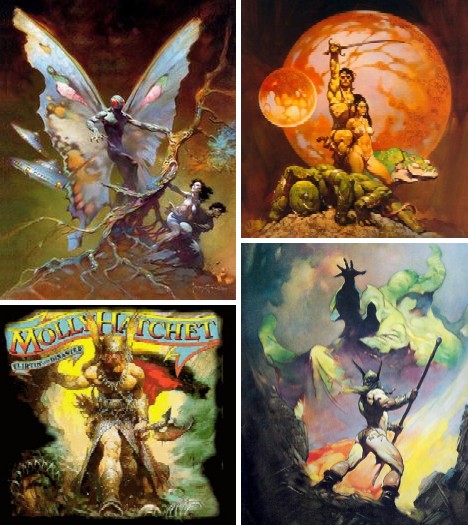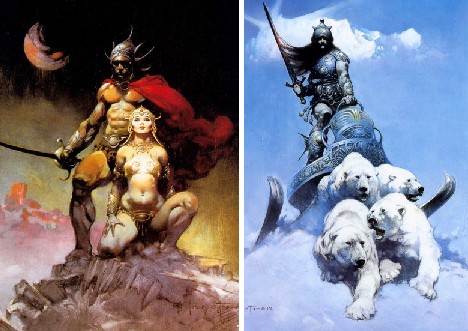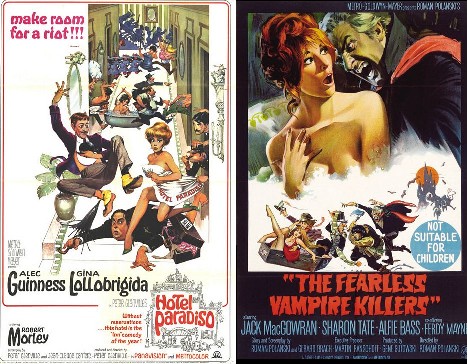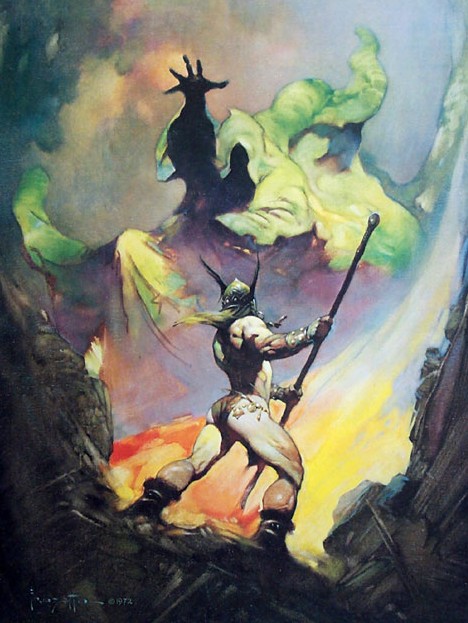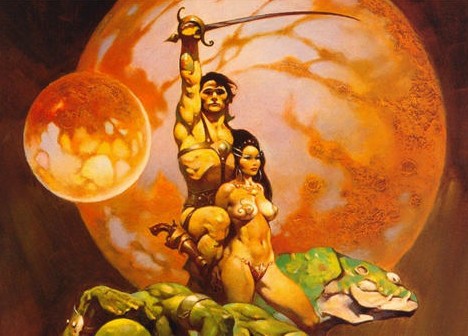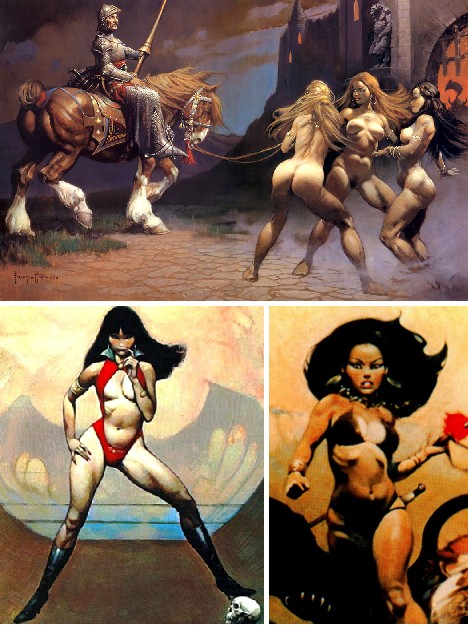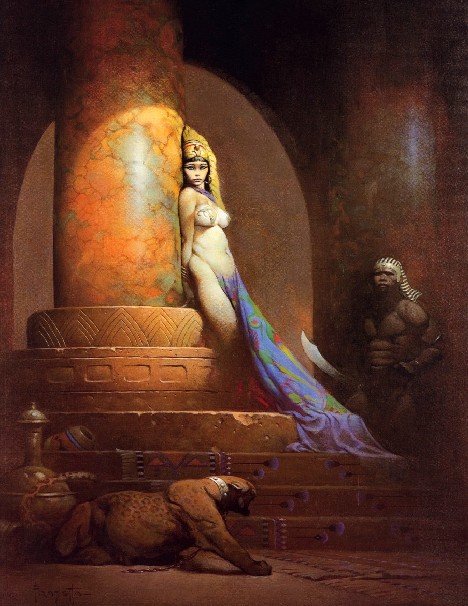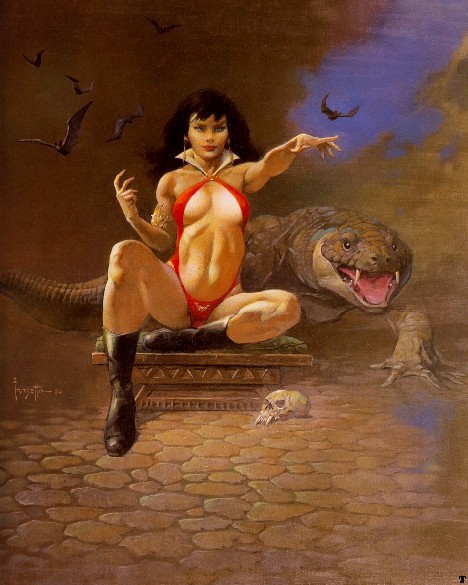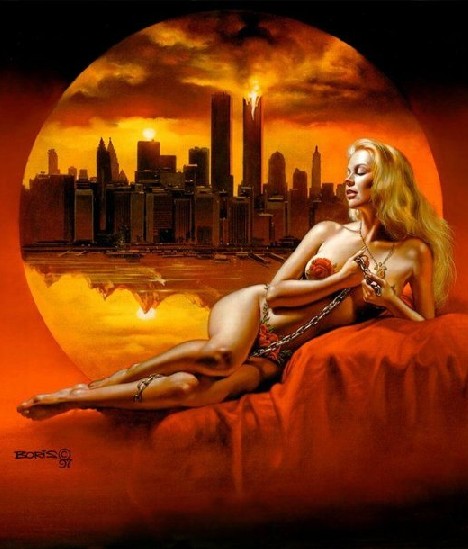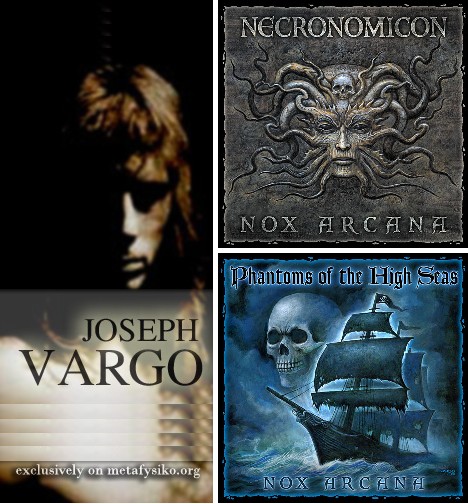Frank Frazetta (1928-2010), perhaps more than any modern artist, managed to bridge the gap between past and future while bringing both to brilliant life in the present. Evoking primal emotion, potent eroticism and essential human values, Frazetta’s portrayals of powerful heroes and voluptuous heroines set in spectacular scenic vistas set the tone for today’s revival of the visual imaginary arts.
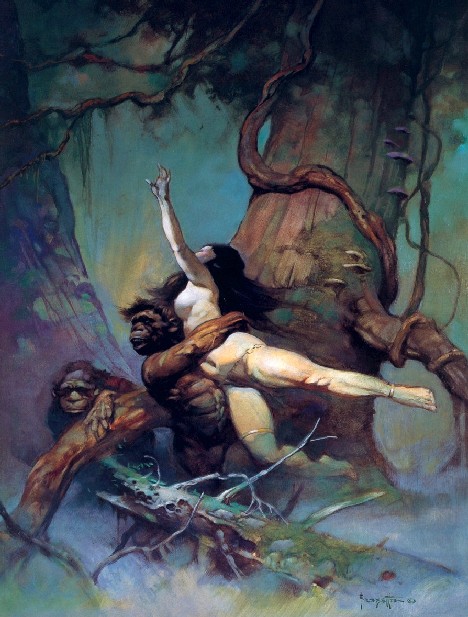 (images via: The Sudden Curve, Flimsy Rationales and Cryptomundo)
(images via: The Sudden Curve, Flimsy Rationales and Cryptomundo)
Frank Frazetta… you might not know the name but his art, once seen, tends to stay with you. Over the past half-century, Frazetta’s work has indeed been seen, and often: from comic books to movie posters to album and book covers, “FF” has helped paint the popular picture of pop culture in the post-war era.
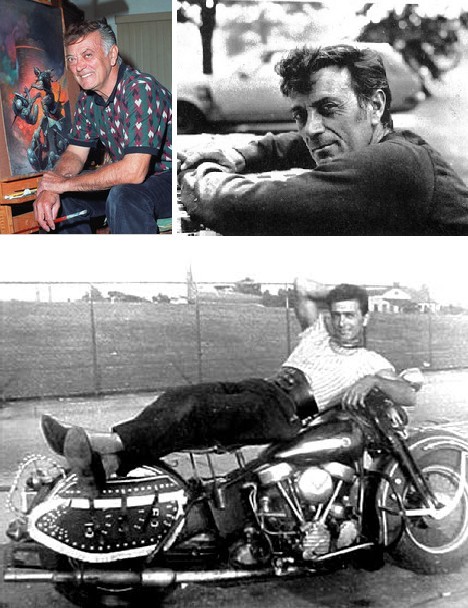 (images via: Cryptomundo and Thing Of It Is)
(images via: Cryptomundo and Thing Of It Is)
Born in Brooklyn, NY in 1928, Frazetta showed an aptitude for drawing while still just a toddler. He credits his grandmother for both encouraging him and for providing him with artists’ materiel during tough times when such things were considered luxuries. Recalled Frazetta, several weeks before his death on May 10, 2010, “When I drew something, she would be the one to say it was wonderful and would give me a penny to keep going. Sometimes I had nothing left to draw on but toilet paper.” Now that’s commitment for you.
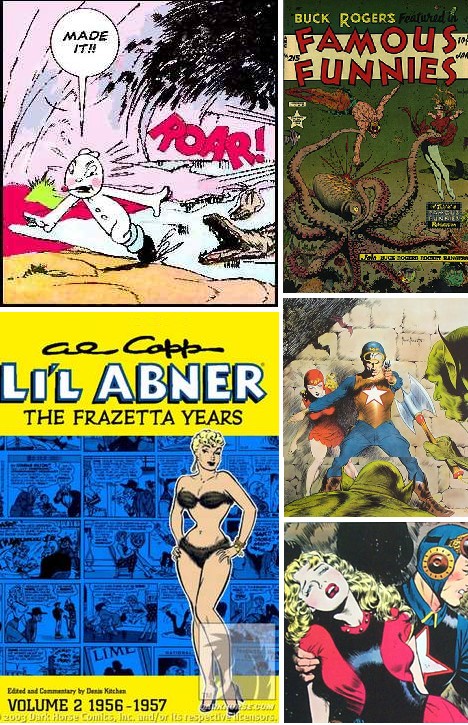 (images via: Bookpalace, Poulpe Pulps and Darkhorse)
(images via: Bookpalace, Poulpe Pulps and Darkhorse)
Frazetta began attending the Brooklyn Academy of Fine Arts at the precocious age of 8, and by the time he turned 15 he was being paid for pencil clean-ups and “ink ins” for Bernard Baily of the Baily Publishing Company.
 (image via: 3D-Total)
(image via: 3D-Total)
For almost 20 years, he worked steadily drawing and painting comic book art for a wide variety of genres. Frazetta’s work can be seen in EC Comics, Buck Rogers comics, Al Capp’s Li’l Abner comic strip and, in the early 1960s, Playboy Magazine’s groundbreaking Little Annie Fanny series with creator Harvey Kurtzman.
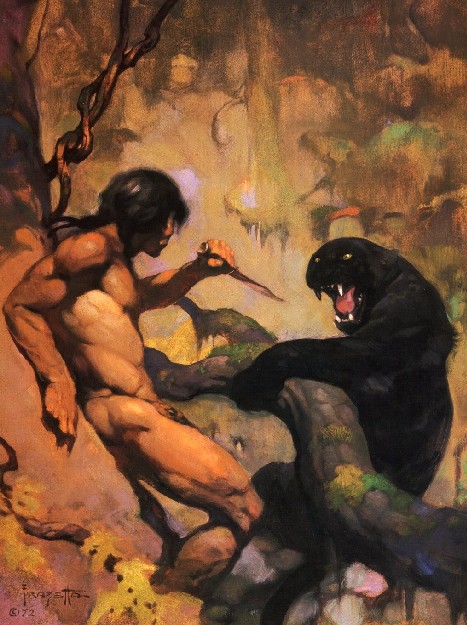
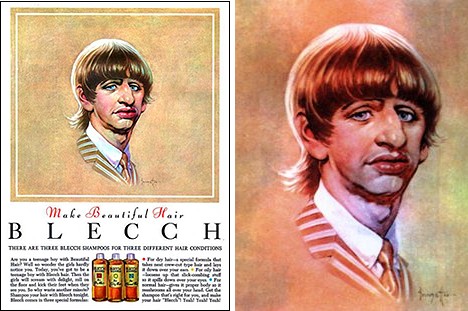 (images via: New Music Talk, Absolute Elsewhere and Spyder’s Random Things)
(images via: New Music Talk, Absolute Elsewhere and Spyder’s Random Things)
Frazetta’s work gradually shifted from drawing to painting and other forms of graphic art, showcased by book covers composed for Ace Books’ Tarzan series and a memorable MAD Magazine parody ad featuring Beatles drummer Ringo Starr in 1964.
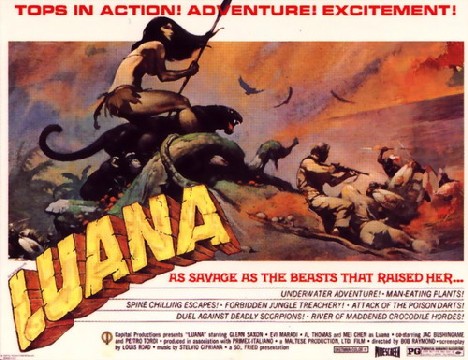 (images via: Imp Awards and Sparehed)
(images via: Imp Awards and Sparehed)
It was the MAD back cover that brought Frazetta his first commission from Hollywood, when United Artists studios hired him to create a movie poster for the Peter Sellers film “What’s New Pussycat?” His work was well received and Frazetta was well paid: that first commission paid more than his current annual salary. Other 1960s movie posters distinguished by Frazetta’s artwork included those for After The Fox, The Fearless Vampire Killers and something called “Luana”.
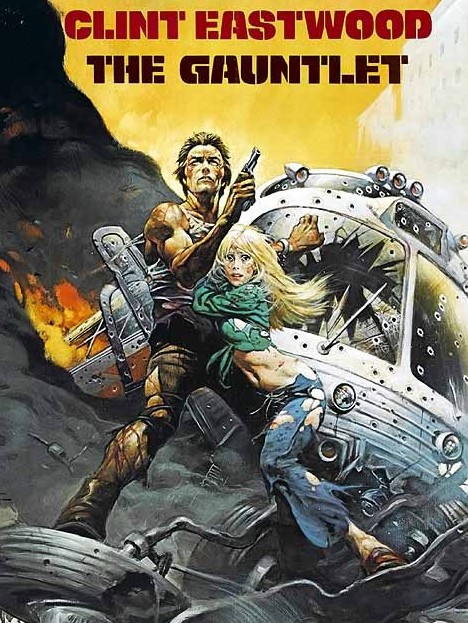 (image via: WorldArt)
(image via: WorldArt)
A notable example from the 1970s is the poster for The Gauntlet, starring Clint Eastwood.
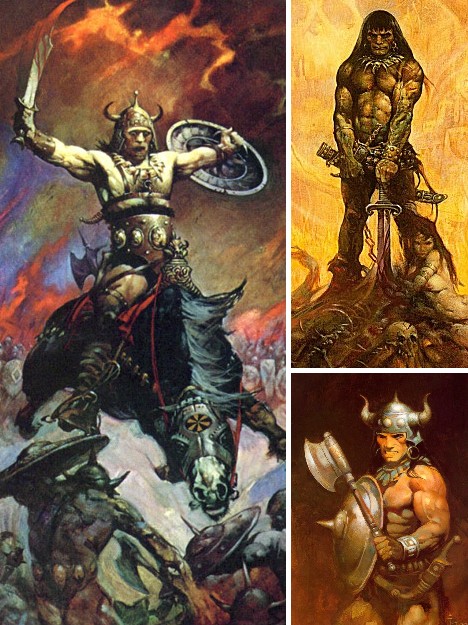 (images via: Bookpalace, Ant’s Home Page, SciFi Wire and Collector’s Quest)
(images via: Bookpalace, Ant’s Home Page, SciFi Wire and Collector’s Quest)
The 1960s and 1970s not only saw Frank Frazetta establish himself as a master of his craft, but witnessed his domination of popular art celebrating the stereotypical manly hero and buxom female heroine – or at least, love interest. It’s widely held that Frazetta’s visual concept of author Robert E. Howard’s “Conan the Barbarian” wholly changed the perception of that character, as well as defining how characters in sword & sorcery fiction would thenceforth be portrayed.
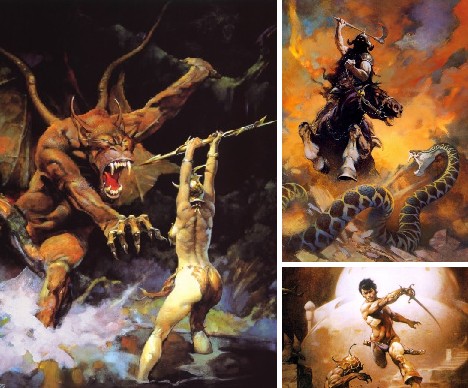 (images via: Cryptomundo and Painting-Palace)
(images via: Cryptomundo and Painting-Palace)
Reissues of the works of author Edgar Rice Burroughs in paper back and book club editions did much to bring Frank Frazetta’s bold style to the attention of a whole new generation of readers. Though Burroughs’ Tarzan books were given a fresh face, it was his Barsoom novels featuring the heroic archetype John Carter that gave Frazetta a platform upon which he could seamlessly meld historic themes with futuristic settings.
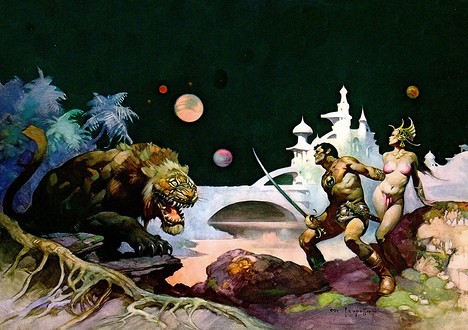 (image via: Kiel Bryant)
(image via: Kiel Bryant)
This panoramic tableau from Burroughs’ Barsoom novel “Thuvia, Maid of Mars” epitomizes Frazetta’s singular style. It’s likely many a young reader found his or her eyes drawn first to the voluptuous Thuvia, next to the muscular John Carter, then to the ravenous Martian beast bearing down on them.
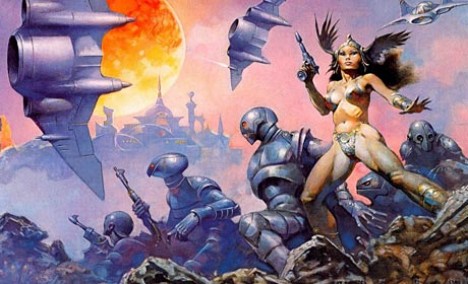 (image via: Film Fetish)
(image via: Film Fetish)
Was Frazetta inspired by Burroughs’ novels? Not a bit – “I didn’t read any of it,” he explained once in an interview. “I drew him my way. It was really rugged. And it caught on. I didn’t care about what people thought. People who bought the books never complained about it.” I know I never did!
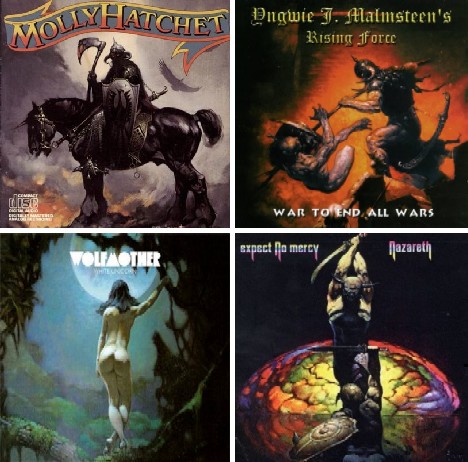 (image via: Spyder’s Random Things)
(image via: Spyder’s Random Things)
As adolescent readers moved on to more musical types of entertainment, they took their appreciation for Frank Frazetta’s artwork with them… and record company artistic directors knew it. The rock genre of Heavy Metal seems to be a perfect match for Frazetta’s heroic artwork, and his paintings were featured on a number of classic rock albums by Nazareth, Molly Hatchet, Wolfmother, Yngwie Malmsteen and others.
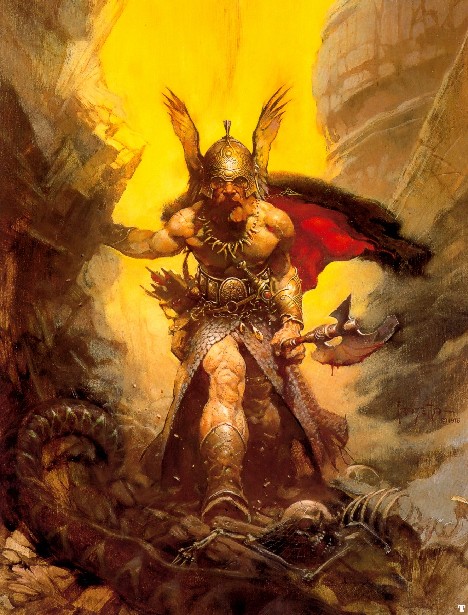 (images via: Able2Know, UULyrics and WorldArt)
(images via: Able2Know, UULyrics and WorldArt)
Frazetta’s work was prominently featured on albums by Molly Hatchet, most notably on their second and most successful release, 1979’s “Flirtin’ with Disaster”. The album hit number 19 on the 1979 charts and is rated today as the groups only album to go Double Platinum. One wonders if Frazetta’s riveting “Dark Kingdom” cover art had more than a little to do with that
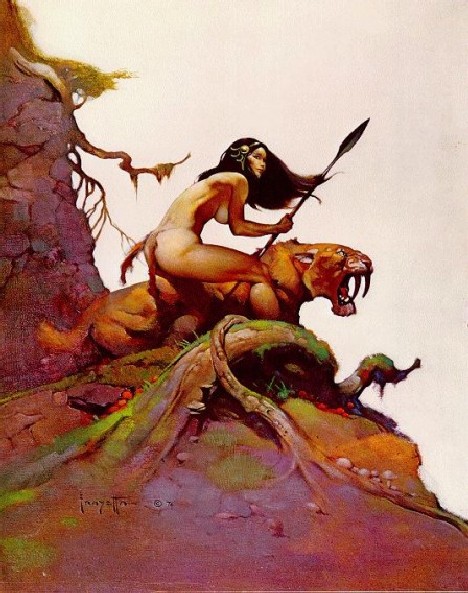 (images via: Famozz, Erin Kubinek and Painting-Palace)
(images via: Famozz, Erin Kubinek and Painting-Palace)
While Frazetta’s record album art often explored the mythos of the medieval barbarian, he is perhaps better known for his portrayal of women. Voluptuously endowed yet not quite Rubenesque, Frazetta’s females exude an intense, primal fierceness that allows them to stand toe to toe with their male counterparts.
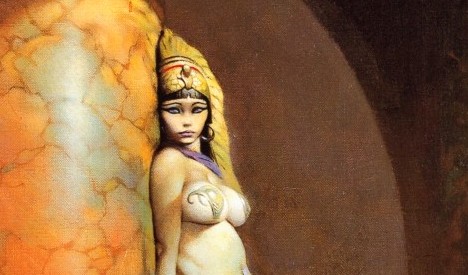 (image via: Comic Art Community)
(image via: Comic Art Community)
It is to Frazetta’s credit that he was able to imbue his female subjects with a sense of power and independence that more than balanced the viewer’s tendency to see them as mere sex objects. A prime example is the painting “Egyptian Queen”, above.
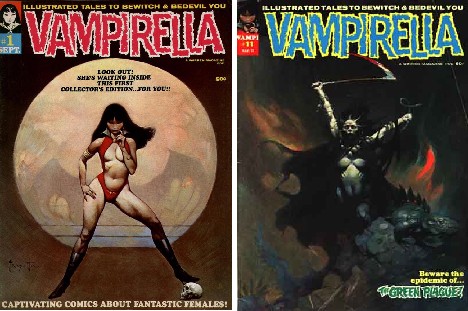 (image via: FrankFrazetta.org)
(image via: FrankFrazetta.org)
Frank Frazetta’s conception of the comic book icon Vampirella is perhaps one of his most famous. Whether on the cover of a comic book or centered in a full-scale painting, Frazetta’s Vampirella consummately delivers the ultimate in dangerous sensuality.
 (images via: Cryptomundo, Razorblade Cookies and IranCartoon)
(images via: Cryptomundo, Razorblade Cookies and IranCartoon)
Late in life, Frazetta suffered from declining health compounded by a long-neglected thyroid condition. A series of small strokes over the past few years stole from Frazetta his greatest talent – the ability to draw and paint with his right hand. The loss of his wife of many years, Eleanor “Ellie” Frazetta (above, left) in the summer of 2009 after a year-long battle with terminal cancer was a bitter pill to swallow. The end came for Frank Frazetta on May 10, 2010, when a final stroke took his life.
Here’s a short video trailer for the documentary film “Frazetta: Painting With Fire”:
 (images via: Designers Revolution, Metafysiko and On1ineCinema)
(images via: Designers Revolution, Metafysiko and On1ineCinema)
Though Frank Frazetta has gone, his immense body of work will continue to affect and impress the many who will follow in his footsteps. One of those is Boris Vallejo. Another is Joseph Vargo, American Gothic artist and musician with Nox Arcana.
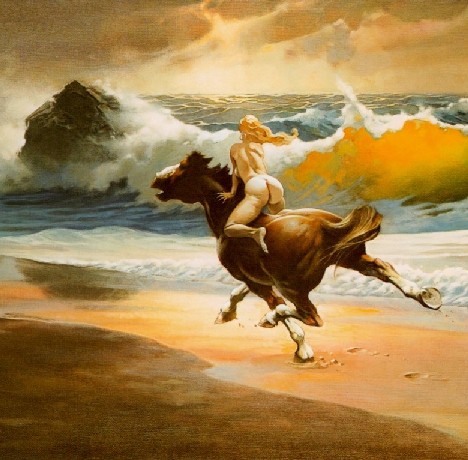 (image via: Anime Only)
(image via: Anime Only)
When asked about his creative inspirations, Vargo replied “My primary artistic influence has always been the legendary fantasy artist Frank Frazetta. His paintings are seething with raw power and energy, but they also have a dark beauty.” Power, energy, beauty… Thanks Frank, it’s been a wild ride.
